Executive Summary
The main objective of this final report is to prepare an IT strategic plan for Perisher Blue Pty Limited. Australia’s biggest and most popular ski resort Perisher Blue was established in 1995, which provides alpine runs, cross-country skiing, valley and bowl skiing, snowboarding classes, snowboard equipment, clothing, jewelry (Hearne, 2009). However, this paper will consider the purpose of IS strategy, advance knowledge sharing process internal, and external business objectives.
The next part of this report is considering the literature review to demonstrate the indicators of the major applications of management information system and e-commerce issues. In addition, this IT strategic plan concentrates on the critical success factors, environmental aspects, business process flowchart and so on. This report also suggests about applications system, data processing, store, technology infrastructure, and IT management process of Perisher Blue. At last, this IT strategic plan provides an IT action plan, which concentrates on issues and problems deliberating from the strategy, implementation schedule, and outsourcing.
Introduction
- Topic: IT strategic plan of Perisher Blue Pty Limited;
- Problem statement: Perisher Blue Pty Limited has already integrated Information technology, but due to expanding nature of its workload and the necessity to integrate with the mother group, it will need to have an IT Strategic Plan.
- To address the problem: To organize the paper, this report will address the purpose for IS strategy, a summary of business strategy, Business Process and Information Requirements, Recommendation, and IT action plan. In this way, this report has been deliberated keeping its keen attention to the background problem.
- Thesis statement: Nowadays information technology changes the work behavior of the managers and the traditional management work. The knowledge-sharing process and networking in every possible arena make Perisher Blue gain the economic scale of advantages.
Purpose for IS Strategy
According to Perisher Blue (2010), Perisher Blue’s IT strategic plan will significantly help the company’s customers to ease up their access to its villages like Perisher Valley, Smiggin Holes, Mount Blue Cow, Guthega, Piper, Rocky Knob, Blue Calf, and other services such as the Skitube alpine railway and ski slopes. The proposed IS infrastructure would raise the number of visitation levels, keep the number of visits at usual rates even in unfavorable weather circumstances, and ensure the latest technological support to the visitors who are coming to the villages.
The IT strategic plan will help the company to get a long-standing structural design for the overture of systems and technological assets, which would assist better access to its wide-ranging amusement activities such as PlayStation Slopestyle Park, Coca-Cola Leichhardt Park, Columbia Fun Club, Bazil’s, Dini’s Sports Bar, Snow Gums, Jax Bar, Char Grill, etc. The IS strategy’s purpose is to contrive and merge all the facilities (for example, resorts, villages, amusement parks, bars, and other facilities) of Perisher Blue Pty altogether in a single IT platform in order to meet all the technological needs of the customers and ensure their highest possible convenience through the introduction of the latest IS architectures.
This plan symbolizes the integration of thoughts and needs for a comprehensive corporate view of how to handle the IT assets of the company; the strategic plan has different purposes for Perisher Blue starting from integration of IT in its organisational-structure by which the basic business is carried out to the accumulation of IT in the services that it offers. The designation of the IS plan will assist the company to the attainment of the corporate aims such as ensuring a strong, safe and long lasting IS architecture in position which assists suitable and foremost edging performance, and appreciates productive departments to formulate perfect utilization of existing and growing technologies.
Although Perisher already have e-commerce sites, the improvement of those sites would denote that the consumers could purchase and book its services in advance in single click remaining at their residence; this would ensure that they are feeling convenient and are satisfied about Perisher’s IT services thus contributing to sales- as customers will find it more effortless and economical. However, it has to be noted that the idea is to bringing altogether all the services and products offered by Perisher in a single IT platform. Although it possesses e-commerce sites, all of those are in a scattered position offering single services individually.
This means that if its entire products and services list is brought under one roof, then the customers can select their preferred villages, tours, bars, programs, etc. more easily; they do not have to look for different things in different places. Besides of that, when a customer would log on in the site, he/she can come to know about all the services its offers looking for one; this means that the e-commerce site could also act as a promotional tool.
According to ComOps (2010), more recently, Perisher has chosen ComOps, one of the foremost Australasian suppliers of corporate software products and services as part of an incorporated resort wide risk-management program; the company would introduce the ComOps Salvus protection and occurrence management reporting software in its system by substituting its existing manual Excel spreadsheet based system for reporting safety incidents. The web-based solution will include dashboards for real time reporting, analysis and management of worker safety and procedures; Salvus will computerize the management of job-related health, security, and possibility information certifying that the company remains acquiescent with the most recent laws upsetting the industries.
Overview/summary of business strategy
The overview/summary of the business strategy will mainly focus on the current business strategy of Perisher Blue. However, this company would like to review its business strategy for more advancement in its operational system and eliminating inefficiencies to make a fully integrated, visitor-focused organisation by adopting IT strategic plan.
- Perisher Blue encourage the adoption of innovative technologies and approaches to their use;
- Experience of Perisher Blue is the key asset of the company because visitor of the company impressed by observing the experience they have with regard to the ease of access throughout the business plants;
- Perisher Blue knows IT infrastructure should design to accommodate planned visitation stages, be able to do so under adverse conditions, and be of a standard, which complement the first-class services in the village and on the mountain;
- The CEO believed that instead skiers and snowboarders should be able to glide through the lines whilst their location as well as access privileges are automatically determined.
However, the following points broadly analysis the internal and external Analysis of business objectives, SWOT analysis and critical success factors of Perisher Blue.
Internal/External Analysis of Business Objectives
The vision of Perisher Blue is to be Australia’s greatest four-season destination mountain resort, offering outstanding facilities, based on ecologically sustainable improvement principles (Perisher Blue, 2010). As a result, this IT strategic plan intends to study on the improvement phases of information technology to examine the strategy of Perisher Blue along with the possible initiatives for further development. Another objectives are re-examine present IT environment, develop IT solution leadership for Perisher Blue, advance communication plan, boost quality assurance method, and concentrate on escalating the capability and efficiency of IT solutions.
SWOT Analysis of Perisher Blue Pty
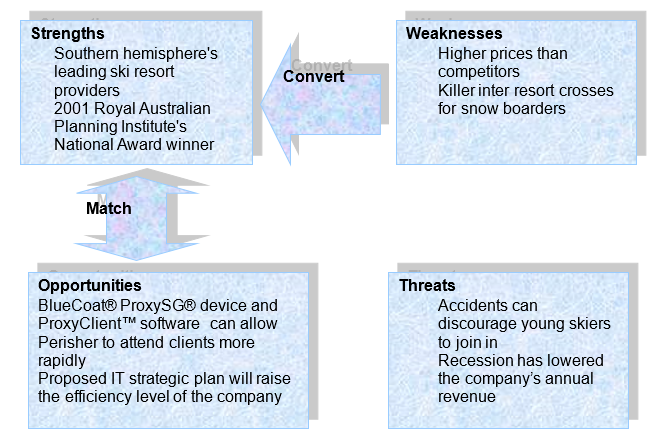
Strengths
- Perisher Blue is the southern hemisphere’s leading ski resort providers offering a wide range of facilities to the customers;
- According to Perisher (2010), its Ski-Slope Master Plan got the 2001 Royal Australian Planning Institute’s National Award for Planning Excellence (ecological designation and preservation) for its exceptional and responsive planning; it also has experienced and efficient employees to implement the IT strategy for the future development of the company;
- By the next few months, the company is becoming more skilled in terms of technology as it has chosen ComOps (prominent supplier of software products and services) as part of an incorporated resort wide risk-management program; the company would introduce the ComOps Salvus protection and occurrence management reporting software in its system increasing its technological expertise;
- Regardless of the global financial downturn, the number of skiers were normal because at that time the company offered many entertaining programs at fairly reasonable prices;
- Perisher blue also has a very strong financial potential to contend with a number of other ski resort providers around the globe;
- It has the potential of attaining the skiers for a long time. Therefore, it has many loyal customers and it has websites, which also helps it extends and familiarize its activities all over the world.
Weaknesses
- Goldsmith (2010) stated that Perisher’s resorts charges higher prices than those in Europe, North-America and Japan; according to that survey, Perisher’s 5-hours drive from Sydney charges A$105 for 1-day lift pass, compared to A$100 in Canada, A$70 in Switzerland and A$65 in France; the Japanese ski resorts charge $63 and $49 respectively whilst New Zealand’s resorts charge only $68;
- Comparably higher prices mean that in global context, Perisher would be a weaker participant, as foreign tourists would find it more economical to visit the competitor’s resorts other than Perisher’s (Sutton, et al., 2010);
- The travellers often try to keep away from the killer inter resort crosses for snow boarders.
Opportunities
- Calif (2010) argued that Perisher has employed BlueCoat® ProxySG® device and ProxyClient™ software from the technology-leader in Application Delivery Networking, Blue Coat Systems, to develop its business operations, allowing it to attend clients more rapidly; using BlueCoat WAN optimization, Perisher can boost its customer-service and enable skiers to get on the ski lifts more swiftly;
- The proposed IT strategic plan for Perisher will very soon raise the efficiency level of the company saving time and raising productivity.
Threats
- Taylor (2008) stated that two men were killed by ploughing into trees on ski resort runs at Mt. Blue Cow and Perisher Valley, whereas a 3rd man was trapped in an avalanche whilst skiing near Charlotte’s Pass in 2008; accidents like this are raising day-by-day which are discouraging many young skiers to join in lowering the number of travellers;
- The global financial crisis had a significant impact in lowering the company’s annual revenue.
Critical Success Factors
Organizational Structure
The organizational structure of Perisher Blue is quite complex and dissimilar from any other single product/service business as it has a number of villages and many bars, restaurants, and other facilities with diverse purposes. In addition, the following figure demonstrates the business structure of this company, which is indeed a multifaceted technology based business:
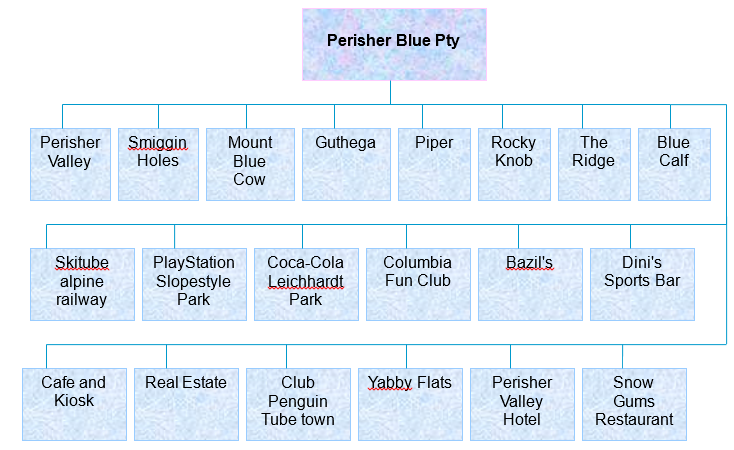
Service Range
Perisher blue holds an extensively huge entertainment services like villages like Perisher Valley, Smiggin Holes, Mount Blue Cow, Guthega, Piper, Rocky Knob, The Ridge, Blue Calf, and other services such as the Skitube alpine railway and ski slopes. Some of the amusement facilities include PlayStation Slopestyle Park, Coca-Cola Leichhardt Park, Columbia Fun Club, Bazil’s, Dini’s Sports Bar, Jax Bar, Char Grill, etc. Perisher also have a number of shopping services, Cafe and Kiosk, Real Estate, Club Penguin Tube town, Free guided mountain Host tours, Groomer tours, Cross country, Telemark, Snowshoe, Kids Snow Rutz, Perisher Ski Patrol, Yabby Flats, Perisher Valley Hotel, Snow Gums Restaurent, Spring Season Lift Passes Specials, and so many other services as well.
Compatibility with partners
Perisher maintains a very friendly relationship with its suppliers of hardware, technology, and many other construction companies. Good interaction between the suppliers, other associates, and Perisher can stand to be a key success factor of the business; however, although it is quite difficult for a business to keep up the affiliation with so many direct, upstream, and downstream associates, this interaction can be performed easily using online chat room software. Through the online chat room software, Perisher can easily contact with its partners more cheaply and efficiently. Thus, by improving its communication systems under this IT infrastructure of a chat room would contribute to a more skilled supply chain management.
Organisational politics
Perisher has very well built organizational rules and policies to oversee and supervise the dealings and functions of the company to achieve the time-consuming goals and objectives. The company’s new IS architecture can play an important role to protect the organisational rules and regulations in all spheres of the business in order to achieve the protracted plans.
Environmental factors
Perisher Blue aims to attain a sustainable balance between the safeguard and preservation of the environment implementing its social responsibilities; in order to do so, the company maintains an Environmental Management System (EMS) framework for measuring the impact on the atmosphere, setting objectives to lower those impact, scrutinizing environment management performance and conveying the results. The two main targets of the company’s EMS are to discover and diminish its adverse affects on the atmosphere and to improve its environmental-management performance; the EMS has developed with specialist support by the National Parks and Wildlife Service (NPWS) for the Perisher Range Resorts.
Customer base
Perisher Blue holds an extremely strong customer base for the reason of its extensive ski-resort facilities and for the superiority of those facilities. Besides of that, it also has numerous loyal customers. Most importantly, there are a large number of young loyal skiers because the company organizes several ski-learning programs from where people can learn to ski. However, in recent days, there is a slight decline in the number of visitors because of two reasons; firstly, the economic downturn, and secondly, the increasing rate of ski accidents. Nevertheless, the growing concern among people to learn skiing can very soon solve this problem.
Networking
Perisher’s strong and widespread networking facilities entrench to a large part of the southern hemisphere, consisting of internal and external network arrangements, data and voice transmission, wired and wireless networking components, and many other exclusive devices.
Business Process and Information Requirements:
Current systems assessment
Perisher Blue (2010) enlighten that Perisher’s explores information about distinct lines of services by using the IT strategy, which are supportive for potential visitors to discover their snowy tourism at mountains with reasonable prices and they would be able to know any required information without expensive communication by just login the web site and it will decrease of customer costs. Due to Perisher‘s overall strategy has purely be a sign of enhanced instance of IT integration for user-friendly attitude that generate customers satisfaction of overall market partners in the context of competitive leadership, for which e- business strategic implications of Perisher Blue strives, are as –
How the changes will affect existing business processes:
- The existing business process demonstrates that Perisher Blue is enough diversified company keeping its successful real state footprint, consequently by introducing the new process would be more effective for Perisher Blue;
- The existing process had no direct connection with the decision making procedure as well as other management functions;
- The existing process of Perisher Blue also ignored several vital issues like data collection and storage, IT infrastructure, software development, along with IT solutions;
- Under the existing system the employees were reluctant about the goals of the Strategic IT Plan;
- The existing web presence of the Perisher Blue is not fully automated to generate orders and payment from a single entry, but an isolated hazardous condition.
Business process redesigning assessment
The new business model flowchart process has demonstrated as below, which is simple for Perisher Blue, although this process has consequence as it has direct link with the mission, vision, values, and other strategically tools of the organisation. The diagram below demonstrates the union between the diverse entities within the business units as well as constrains the progress of the IT Strategic Plan. In addition, this process incorporates the segment and office objectives in order to amplify the business-view of the technology applications.
Upon implementation of the strategic bearings, the Information Technology improvement projects have selected as a major source of meeting a strategic goals. Perisher Blue maintain the standard for choosing the projects based on external environmental aspects including trade advantage, risk mitigation, cost estimation, technological feasibility and global recession, cultural issues, human resource, supply chain management, control of administration as well as data analysis process.
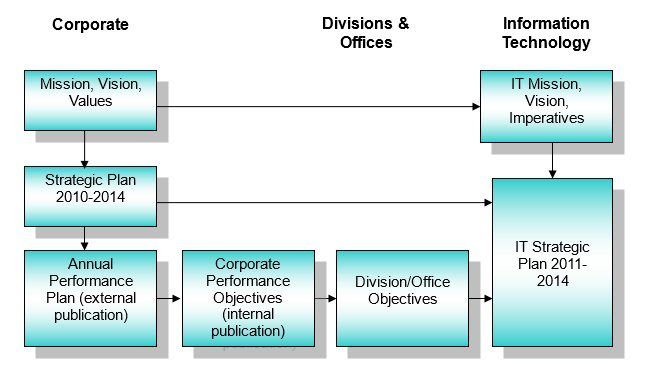
Diagram number six demonstrates the correlation between information processing activities and management activities where management activities are directly consistent with information processing systems. Each part of the line is targeting towards the productivity and organisational vision of Perisher Blue. Moreover, its business channels and decision-making process will distribute consistent with the database management system as well as the knowledge sharing system rely on the logistics support.
Additionally, the planning process is completed with the depicting the models and decision by utilising the end user software and the planning function performed with the model building software, for example, Visio and Microsoft project. However, the decision process is ended the expert system related software. Here, it is important to mention that the coordinating function is correlated with the simulation multiplier and controlling process is linked with inspection the performed work and the observing the fluctuations from standard level. Perisher Blue will utilize the control and monitoring software to accomplish the function.
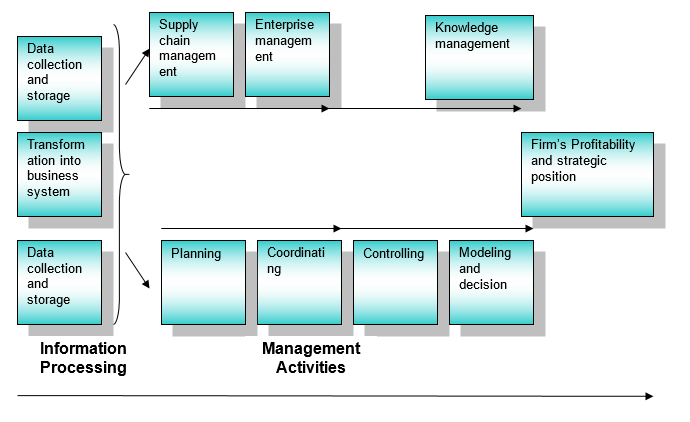
Argument for new IS/IT opportunities
- Perisher Blue will get advantage from new dynamic and productive IT planning process as it monitors and ensures all IT planning conforms to the Strategic IT policy;
- In addition, it changes the working attitude of the managers, the decision makers and employees;
- New system will advance knowledge management practice, Enterprise management and online booking;
- IS strategy is also significant for restructuring the management process by implementing powerful technology for more specific scheduling, forecasting, and scrutinizing.
- Most of these processes have inter-connection with networking system.
Recommendations
Applications
Perisher Blue recently uses following applications –
- Perisher Blue (2010) reported that Perisher uses Corporate Windows 2003 Servers as these servers host a range of business critical support applications as well as support services;
- SQL database and network;
However, this report recommends following applications for the further development of Perisher Blue –
- To contact with the visitors, customers, suppliers, and individuals, Perisher Blue ought to develop a new e-business application system because Local Loop Unbundling (LLU) is reduce operating costs due to lower investment for application;
- Perisher Blue should use this application when the company decides to lunch any new business units, as developing applications to plant layout, and process layout largely contribute for further development;
- Perisher Blue should incorporate enterprise resource planning (ERP) and SAP application system to develop contact system with visitors;
- Introducing these software applications, Perisher Blue can save valuable time and operation costs over the inventory management, as a result, it should continue inventory management application system;
- In addition, Perisher Blue should develop TQM application to control the product quality in every process of its production segment;
- Software Asset Management (SAM), Computer Assistance Learning (CAL), and Management System for International Transportation are also important application for Perisher Blue.
However, the following figure shows the integrated ERP system, which is important for the function of Perisher Blue.
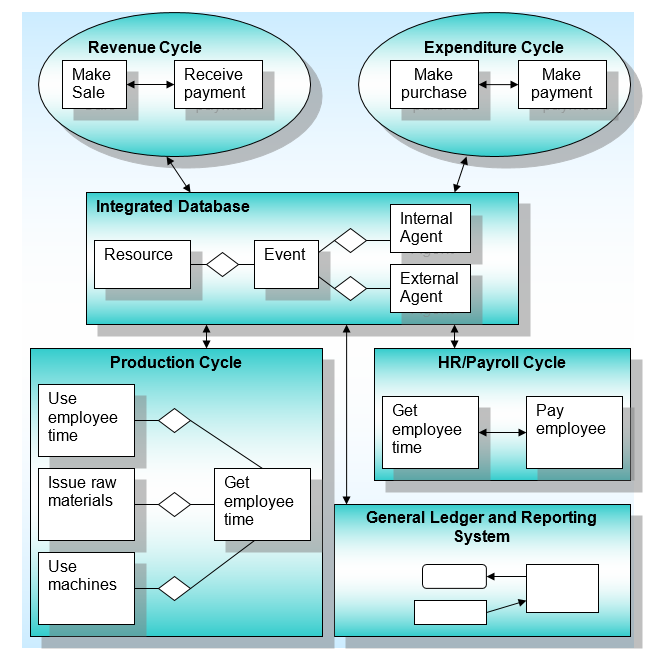
Data
- Perisher Blue had introduced web-based portal for booking and shopping. This portal generates huge data, which also subject to privacy of visitors and customer, as a result the IT system should develop to follow Data Protection Act
- Perisher Blue (2010, p.5) reported that the IT recommended should also provide data that will facilitate better skier management and control on lift queues and other resort facilities;
- Material safety data sheets (MSDS) have to be available for all stored chemicals;
- There is a permanent scientific site (the NPWS site database).
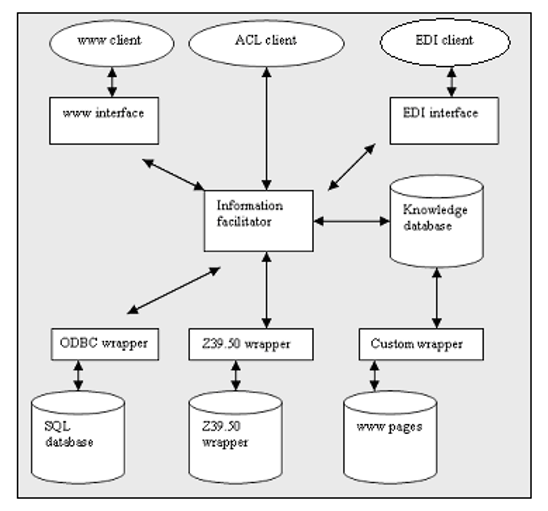
The diagram-7 illustrates the inter link of databases such as, www, wrapper, and Open Database Connectivity. It shows that the www interface, which requires to collect the information about the suppliers and clients. In next stage, the SQL databases integrate with the collective data and store while the database contains the relative information about businesses, customers, suppliers, and other segments. However, the Z39.50 wrapper use in order to support the information about the www interfaces and the information facilitator is gathering all sorts of information, which collected from agent communication language (ACL). However, the rules and constraints store in the knowledge database to uphold the demand for required queries.
Technology infrastructure
Perisher Blue Pty Limited always focus more on its information technology infrastructure as it helps to decrease the hazards inherent in natural disaster, terrorist, and other prohibited conducts. According to the view of Laudon & Traver (2002), the IT infrastructure should optimize or innovative to improve the elasticity and quality of the infrastructure with the intention that the unit’s ability to deliver upgraded services and reduce the threat. However, this report will present an IT infrastructure model with five levels, which categorizes key problems to extend IT systems for each section.
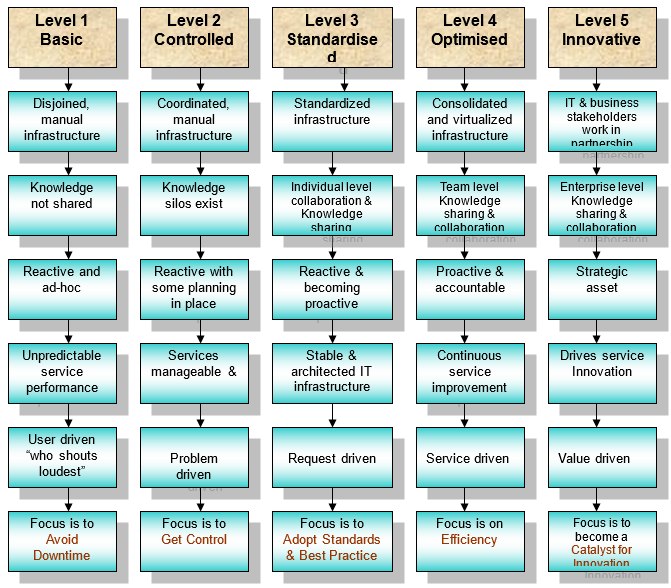
The above figure demonstrates five levels of the model where Perisher Blue position is near the final stage of the model. However, it would occupy this stage for a long-time by adopting most recent technology in every sector of its operation to confirm IT investment alignment, infrastructure consolidation, achieving economies of scale and decline in replication of IT capabilities.
On the other hand, the most important purpose of this infrastructure development model is to assess current capabilities along with present position in this infrastructure model and take further initiative to reach level five. However, Perisher Blue carry out these tasks by applying different electronic technologies by developing communication, transaction, distribution channels, improved customization and business processes, involvement in e-commerce, modified structure and level of specialization, ad making strong relationship with the present customers through Information Technology.
IT management process
It is unfortunate that Perisher Blue still use many backdated software for communication and IT management process while competitors use upgraded software, for example Perisher Blue uses Microsoft Office 2007, e-mail, MYOB Premier and Team Headquarters Project Management Software;
- At first, the management of Perisher Blue should receive the advantage of the standards outlined with the Information Technology Infrastructure Library (ITIL) because ITIL is a combination of best practices that creates a reference model for the companies to start with;
- The next stage of ITIL application, Perisher Blue can execute the Capability Maturity Model (CMM) in order to transfer from reactive management point to proactive management. Here, it is mention that Infrastructure Development Model of Perisher Blue is also derived from CMM;
- To co-ordinate the communication system among Perisher Valley, Smiggin Holes, Blue Cow, and Guthega, Perisher Blue should develop strong communication system, restructure executive support system, low-volume data, analytic models, and data analysis tools, knowledge working system design specifications, knowledge base, transaction processing system, and management information system;
- IT infrastructure should design to accommodate planned visitation levels;
- Rapid development of IT management process is important to improve optic fibre telecommunications network throughout the resort (Perisher Blue, 2002).
IT action plan
The IT action plan would stipulate the main concerns, capacities, and benefits of the company to assist a variety of enjoyable activities, which balances fun, learning, retailing and amusement occasions; the IT plan would also offer information, which would facilitate enhanced skier organization and control over-lift lines and other resort amenities. However, IT action plan will concentrate on issues and problems deliberating from the strategy, implementation schedule, and outsourcing.
Tactical plan
This Tactical plan for Perisher Blue intended to encourage, guiding, and motivate public perception to develop mass awareness among the target audience with the objectives to conservation, management and proper utilization of the project of Perisher Blue. The impact of this tactical plan is very significant in terms of utilization, conservation and management of Perisher Blue Pty with clear evidence of influencing the public awareness during the plan has endorsed. However, Gary Grant on behalf of the board members of Perisher Blue Pty has engaged himself as the General Manager of Marketing and asked for immediate development of a Tactical plan for IS strategic plan aimed to represent its dominating position in the tourism industry mentioning its role and momentous contribution to the local economy.
Issues and problems arising from the strategy
To meet above demands, this Tactical plan would ultimately develop mass awareness among the target audience with the objectives to boost up elevated attention of the customers towards Perisher Blue. It would also inspire public perception to carry out the message to the target audience that the role of Perisher Blue’s IS strategy, is in actual fact an integral part of IT implemented business system while this drives highlights the campaign with the public slogan “Perisher Blue is the ultimate solution of your tourism at snowy mountains”.
The existing web presence of Perisher Blue has just upgraded the information regarding the events, resorts booking terms and other related information for the customers, but there is no provision for online booking, making payment for which this plan would argue for a fully automated e-commerce site for the company.
Thus, to raise public awareness, this tactical plan endow with an effective implementation policy based on the Information system improvement measures, upgrading of automation know how, materializing environmental legislation and enhancing public enduring with the slogan ‘Perisher Blue is one-step destiny for snowy tourism’, the focal point of the campaign. The influence of this tactical plan is very momentous in terms of operation, conservation, and management of Perisher Blue with clear evidence of influencing the public awareness during the plan has authoritative as integral part of Strategic plan.
Media strategy
The media strategy of Perisher Blue would be established assessing that how consumers can learn more about its projects, which media would be effective to communicate with the target audience, and most essentially, how well turned-out would be the IS architectures for efficient promotional options and essentially decrease the advertising costs. Consequently, the media strategy would deliberate to selecting the best communicating mediums to gain bursting attention of the target customers and the strategy will prefer to select a number of mediums for most excellent promotion the desired awareness.
Media Selection
The tactical plan of Perisher Blue has selected the subsequent advertising mediums for promoting its resorts, events, and services and integrating with the IT architectures as a tool in the promotional performance:
Tourism Magazines & Print Media
State Award 1996 owner Perisher Blue by the Industrial Relations Commission would more emphasis on Tourism and natural science, eco-tourism journals, magazines and newspaper. It also emphasis on the distribution of printed brochure at international flights, airports and hotels describing the facilities and events of Perisher with lucrative scenarios of its sites
Western Tourist Radio & Television Advertising
Perisher Blue would go for media selection with the objective to keep in touch with the international tourism radio and TV campaigns before the next tourist season starts to attain that vision and would launch its first TV campaign from next November to endorse tourist by starting of 2011. This campaign would coordinate with scenario, lift style and maintains profile of the hoary mountains in different areas those Perisher Blue Pty holds as it can also invite the tourists for federal and local government controlled sites and their Perisher will ensure that the customers that the company only deals with superior snowy mountains.
Website Promotion
Perisher Blue has well contented website, but there is not enough marking tools integrated. This IT strategy plan would like to comprise integration of online marketing tools coordination with search engine optimisation, VIDEO clips, and short tourism films uploaded in the website for prospective customers. This inventive would provide direct and website marketing organizations an overhaul in an attempt to enlarge a further integrated approach to its infrastructure and the agents and affiliates would bring extended outcomes and benefits of advertising campaigns for the company.
E-mail advertisements
At present Perisher Blue most common, but not regular e-mail alerts to its customers informing them about its wide raging sites, events and services, due to recent development of this plan it has emphasised on the expansion and development of its IT resources. The new strategy argued to increase its number of e-mail alerts by covering a large number of customer base through predestined colourful e-mail templates.
Outdoor Advertising
Perisher Blue has aggressively highlighting on the outdoor advertising techniques that attract many customers; for instance, neon signs at airport, rail station and luxury bus terminals, billboards at national highways and such campaign to promote tourist’s attention and mostly it will function more effectively to rising awareness.
The advertising strategy of Perisher Blue Pty emphasized the climate change as well as augmented climate unpredictability has nowadays established as an increasing threat that demonstrates massive unhealthy impact on the human heritage and national economy. As part of the tactical plan, impacts of climate change on the Australian heritage, this plan would take into account of an exploratory assessment of climate change on the company’s performance including tourist’s vitiating rates with the aim to draw sustainable way out.
Project implementation Schedule
Approach to Tactical Plan
This Tactical Plan would imitate the target audience of Perisher Blue appreciating and communicating with the sketched out dilemmas and would submit a relevance with the highlighted considerations of the proposed strategies and implement the tactics through social marketing approaches along with IMC tools that would positively reshape the presumptions of target audience. At the same time, it would also show the way to the strategies to acquire vigorous contribution to getting hold of the objectives of Perisher Blue.
Objectives and strategies
Goals of the Campaign ‘Perisher Blue is one-step destiny for snowy tourism’:
- To create eco-friendly tourism accumulating with awareness on environmental sustainability on the local and foreign tourists as well mass people, which is major worth of the Perisher Blue IS strategy,
- To Establishing this tactical plan Perisher Blue is interested to generate community consultation forum regarding the snowy mountain tourism issue that will driver the organization to educating and opening the season from early October of each year and by this way it will increase number of visitor promisingly;
- To educate local and foreign tourists how to utilize the resources of Perisher Blue without troubling the nature and hampering balance of business model,
- To keep keen eyes on the unlawful devastating by the visitors of Perisher Blue,
- To maintain pressure on the law enforcement authority to implement existing law and regulations of environmental hazards and climate chance to protect the interest of Perisher Blue;
- To instructing people for positive behaviours to the Perisher Blue IS strategy.
Target Group
The campaign ‘“Perisher Blue is the ultimate solution of your tourism at snowy mountains” has at this time concerned and targeted the early audiences as-
- Local residents of all ethic groups in All part of Australia.
- Foreigners live in Australia at multinationals businesses concerns and foreign missions.
- Foreign tourist from all parts of the world specially from US and Europe market.
- Politicians’ policy makers and legislators for grand motivation.
- NGOs activists, Educationalist and researchers working this with business arena Perisher Blue.
Implementation Schedule
In the business processes segment of the plan that the project implementation program goes through 2011 –
Outsourcing considerations
The procedure of Perisher Blue’s IT systems are conceded with the combination of outsourced services and outsourcing jobs can be identified as IT enabled services through freelancing or long-term contract with BPO (Business Process Outsourcing) service provider organisations from Bangladesh and India. Perisher Blue’s has also the opportunity to outsource organisational resource planning, corporate intelligence, corporate network, payroll, data centre and desktop infrastructure; the company has planned to expand its outsourcing with a revelation to decrease IT infrastructural investment very soon. In direction to have enough resources for the best customer service, and to implement on IT integration at management level, the company would like to hair some call-centres outsourced from Bangladesh and India.
Conclusion
Implementing the IT strategic plan, Perisher Blue Pty has driven to achieve the position of market leader in the snowy mountain tourism facing major challenges from climate change and other environmental hazards. The environmental activists and NGOs are in campaign against tourism arguing that the tourists are almost destroying the natural heritages. Media, law enforcement agencies are enough concerned with environmental issues.
To overcome these challenges, Perisher Blue Pty has taken its IT strategic plan integrating with eco-friendly tourism. The company already has taken highest measures to educating the visitors with the environmental sustainability. With its snowy mountain region resorts, visiting events it also serves the visitors to state controlled sites like National Parks, Snowy River Shire, as well as Cooma-Monaro Shire while the implementation phase involved with visitors insurance and educating opportunities under this IT strategic plan. Consequently, Perisher Blue Pty will serve an extended number of tourists and gain the business objectives by through enhanced profit generation.
Reference List
Calif, S. (2010) Perisher Ski Resort Enhances Business Performance and Accommodates More Skiers Using Blue Coat Appliances. Web.
ComOps (2010) Perisher Deploys ComOps For Ski Resort Risk Management. Web.
FDIC (2010) Federal Deposit Insurance Corporation: Information Technology Strategic Plan 2008 – 2013. Web.
Goldsmith, B. (2010) Australian skiers brace for world’s top piste prices. Web.
Hearne, J. (2009) Tourism Snowy Mountains. Web.
Laudon, K. C., & Traver, C. G. (2002) E- commerce- Business, Technology, Society. 4th ed. London: Pearson Education.
Perisher Blue (2002) Perisher Blue Ski Resort. Web.
Perisher Blue (2010) The Perisher Ski Resort Ski Slope Master Plan. Web.
Sutton, P. et al., (2010) Assessing the Local Economic Impacts of Climate Change on Tourism: Cooma, an Australian Case Study. Web.
Taylor, L. (2008) Ski deaths unavoidable, says resort. Web.